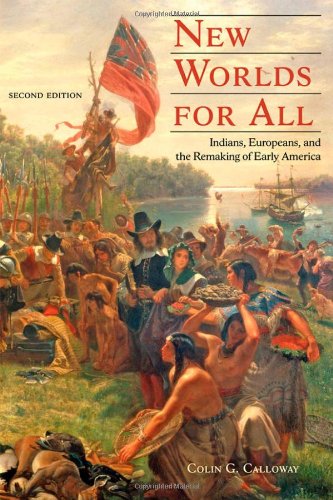Winter Book Discussion
 Five sessions using Colin Callaway’s New Worlds for All.
Five sessions using Colin Callaway’s New Worlds for All.
A book discussion and curriculum reflection series using Colin Calloway’s book, New Worlds for All: Indians, Europeans, and the Remaking of Early America. Participants reflect on how central concepts of the book are or are not reflected in their curriculum and consider ways to engage students in understanding how the remaking of early America impacts us all in the present.
Choice 1: Tuesdays, 4:00 – 5:30 p.m.
January 24; February 7, 28; March 14, 28
Choice 2: Wednesdays, 4:00 – 5:30 p.m.
January 25; February 8; March 1, 15, 29
Course Format: Online on Zoom
Dates and Times
Participants can sign up for either the Tuesday or the Wednesday sessions. Both run from 4:00 – 5:30 p.m.
Registration Fee (includes a copy of the book if you don’t have one):
Cost: $500
Graduate Credit (1 credit available from Castleton University for $150)
Assignments for those taking this for graduate credit:
- Actively participates in the Book Discussions (20%)
- Applies primary source analysis to the content during each session. (40%)
- Final Assignment. (40%)
In a 2- to 3-page reflection, consider the ways in which the central themes discussed in the sessions might be applied to your teaching OR
Develop a primary source activity or discussion that deepens student understanding of a key concept or topic in the book.
January 24/25
Key Questions:
What does it mean to say that the people of early American were “a mixed race”?
What were the significant impacts of “the Columbian Exchanage”?
- Reading: Introduction, “The Kaleidoscope of Early America,”; Chapter 1, “Imagining and Creating a New World”
- Primary Source Analysis: Excerpts from European writings from the early contact period
February 7/8
Key Questions:
What was similar and dissimilar about European and Indigenous perspectives on sickness and health?
How did trade reshape European and Indigenous cultures?
- Reading: Chapter 2, “Healing and Disease”; Chapter 3, “The Stuff of Life”
- Primary Source Analysis: Map cartouche; prints and paintings
February 28/March 1
Key Question:
How does religion embody and express worldviews and cultural values?
- Reading: Chapter 4, “A World of Dreams and Bibles”
- Primary Source Analysis: Early American religious writing; captivity narrative
March 14/15
Key Question:
How did conflict and war reshape Indigenous and European cultures?
- Reading: Chapter 5, “New World Warfare”; Chapter 6, “New World Diplomacy”
- Primary Source Analysis: Wampum belts; Indigenous writings
March 28/29
Key Questions:
How has “the Indian presence” precipitated the formation of American identity?
How can we indigenize our curricula?
- Reading: Chapter 7, “New Nomads and True Nomads”; Chapter 8, “Crossing and Merging Frontiers”; Chapter 9, “New Peoples and New Societies”; Conclusion
- Primary Source Analysis: Maps; captivity narrative; land acknowledgments